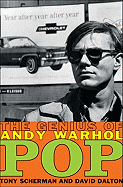
.
Success as a commercial artist didn't open the most important doors, however. Warhol had small exhibits of whimsical mixed media drawings (in the manner of his commercial work) at second-tier galleries in the 1950s, but nobody took him seriously. He asked a friend, filmmaker Emile de Antonio, why his idols Robert Rauschenberg and Jasper Johns (fine artists who were also gay like Warhol) didn't invite him into their exclusive circle. De Antonio answered, "Why Andy, how could they? You're too queer."
To break out of the confines of the commercial-artist box, Warhol began painting in earnest in September 1960, determined to find new approaches that would draw attention and respect. Scherman and Dalton pay particular attention to this period, and their brilliant description of his evolution from 1960 to 1962 essentially defines the genesis of Andy Warhol. His eye for visual snap, openness to accidents and visceral connection to 1960s cultural changes led to his creation of the work we now associate with him: Campbell soup can paintings, Liz, Jackie and Marilyn portraits and, of course, the Brillo boxes. Whenever people asked if he was joking, Warhol would reply that he was dead serious, but with a campy vagueness that left skeptics unconvinced.
Warhol's first show of Campbell soup can paintings, in Los Angeles in 1962, garnered mocking press and sold only one painting (for $100). Los Angeles could laugh, but Warhol had found his groove. When Pop Art toppled Abstract Expressionism from art world dominance at the end of 1962, he was at the center of the movement, and his first New York solo show at the Stable Gallery proclaimed another area of his genius: publicity magnet.
Warhol grew as a brand and a celebrity from 1962 onward no matter what he did and how much he made. We're still mesmerized by him, and the paintings from his brief, truly creative period remain the gold standard (dig it, Green Car Crash (Green Burning Car) from 1963 sold for $71.7 million in 2007).--John McFarland
Shelf Talker: A riveting examination of how Andy Warhol became a legend, complete with delicious details of dollar values, sexual train wrecks, damaged friends, outrageous happenings and even gunfire in the Factory.

